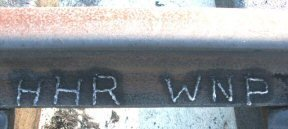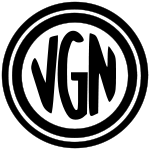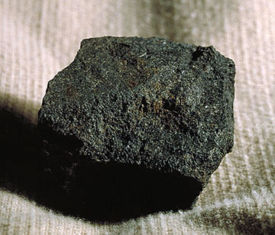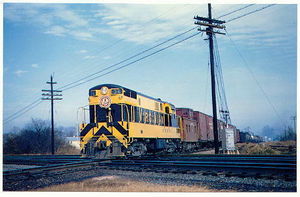Virginian Railway
2007 Schools Wikipedia Selection. Related subjects: Railway transport
The Virginian Railway ( AAR reporting mark VGN) was a Class I railroad located in Virginia and West Virginia in the United States. The VGN was created to transport high quality "smokeless" bituminous coal from southern West Virginia to port at Hampton Roads.
In a classic story of business intrigue, founders William Nelson Page, a coal mining engineer and manager of apparently limited means and his silent partner, industrialist financier Henry Huttleston Rogers, one of the richest men in the world, joined forces and quietly secured right-of-way and then built the "Mountains to Sea" railroad right under the noses of the big railroads and the elite group of a few industrialists (so-called " robber barons") who controlled them.
Completed in 1909, the Virginian Railway was a modern well-engineered railroad with all-new infrastructure and could operate more efficiently than its larger competitors. Throughout a profitable 50-year history, the VGN continued the Page-Rogers philosophy of "paying up front for the best". It achieved best efficiencies in the mountains, rolling piedmont, and flat tidewater terrain. Known for operating the largest and best steam, electric, and diesel motive power, it became nicknamed "Richest Little Railroad in the World." Merged into the Norfolk and Western Railway in 1959, a large portion of the former VGN remains in service in the 21st century for the Norfolk Southern Railway, a Class I railroad headquartered in Norfolk a few blocks from the former Virginian Railway offices in Norfolk Terminal Station.
Its story was first told by H. Reid in The Virginian Railway, published in 1961. Although one of the smaller fallen flags of U.S. railroads, the VGN continues over 46 years later to have an amazingly loyal following of former employees, modelers, authors, photographers, historians and preservationists. Early in the 21st century, many of these now belong to Virginian Railway (VGN) Enthusiasts, which is one of the Internet's most vibrant Yahoo! Railway Enthusiast online groups. A group of retirees in Roanoke, Virginia meet each week and answer questions from a worldwide base of over 700 members. Annual seminars have a growing attendance and preservation activities have been increasing, even as the VGN itself fades into history.
Building the Virginian Railway
The Virginian Railway (VGN) was conceived early in the 20th century by two men. One was a brilliant civil engineer and entrepreneur, William Nelson Page. His partner was millionaire industrialist, Henry Huttleston Rogers. Together, they built a well-engineered railroad that was virtually a "conveyor belt on rails" to transport high quality "smokeless" bituminous coal from southern West Virginia to port on Hampton Roads, near Norfolk, Virginia.
The story of the building of the Virginian Railway is a textbook example of natural resources and railroads, and of a smaller company taking on big business (and winning) early in the 20th century. It was a time when many railroads were under the common control of a few powerful developers, who took on competitors without antitrust restraints.
A partnership: The idea man from Ansted meets a millionaire
William Nelson Page (1854-1932) was a civil engineer and entrepreneur. Page, who was born in Virginia and educated at the University of Virginia in Charlottesville, originally came to West Virginia in the 1870s to help build the double-track Chesapeake and Ohio Railway in the New River and Kanawha River Valleys.
A colorful man by all accounts, Colonel Page, as he came to be known, soon became involved in many coal and related enterprises in the mountains of Virginia and West Virginia, settling in the tiny mountain hamlet of Ansted in Fayette County, West Virginia.
Col. Page was one of the more successful men who developed West Virginia's rich bituminous coal fields in the late 19th and early 20th centuries and build the railroads to transport the coal. With his training and experience as a civil engineer, Page was exceptionally well-prepared to capitalize on southern West Virginia's hidden wealth. Former West Virginia Governor William A. MacCorkle described him as a man who knew "the land as a farmer knows his fields." He was also an energetic entrepreneur. Author H. Reid summed it up by labeling Col. Page "The idea man from Ansted."
Henry Huttleston Rogers (1840-1909) was a financier and industrialist who had grown up in a working-class family in Massachusetts. He began working while young, and had helped part-time in his father's grocery store and delivered newspapers. After graduating from high school, Rogers got experience as a brakeman on a local railroad while saving his money. In 1861 he and a friend set out for the mountains of Pennsylvania, and helped develop oil and natural gas resources there during the U.S. Civil War, eventually becoming one of the key men with John D. Rockefeller's Standard Oil Trust and a multi- millionaire. One of the wealthiest men in the United States, Rogers was an energetic entrepreneur, much like the younger Page, and was also involved in many rail and mineral development projects.
Rogers became acquainted with Page while the latter was president of Gauley Mountain Coal Company, among many other ventures. Page knew of rich untapped bituminous coal fields lying between the New River Valley and the lower Guyandotte River in southern West Virginia in an area not yet reached by the C&O and its major competitor, the Norfolk & Western Railway (N&W). While the bigger railroads were preoccupied in developing nearby areas and shipping coal via rail to Hampton Roads, Page formed a plan to take advantage of the undeveloped coal lands, with Rogers and several others as investors. A powerful partnership had been formed.
Deepwater Railway and Tidewater Railway
The Virginian Railway was built early in the 20th century by building the Deepwater Railway in West Virginia and the Tidewater Railway in Virginia, and then combining them.
Important points on the Deepwater Railway were Page, Mullens and Princeton in West Virginia.
Over in Virginia, on the Tidewater Railway, the principal points were Roanoke, Victoria and Sewell's Point, where a new coal pier was located on Hampton Roads near Norfolk.
Victoria is created
Late in 1906, near the halfway point on the Tidewater Railway between Roanoke and Sewell's Point, a new town with space set aside for railroad offices and shops was created in Lunenburg County, Virginia. It was named Victoria, in honour of Queen Victoria of England, who was long-admired by Henry Rogers.
Victoria was the location of a large equipment maintenance operation, with roundhouse, turntable coaling and water facilities for servicing steam locomotives, and a large yard. Offices for the VGN's Norfolk Division were built by adding a second floor to the passenger station building a few years later.
1907: Virginian railway is born
Only a few months after Victoria was incorporated, in early 1907, the name of the Tidewater Railway was changed to "The Virginian Railway Company." The Deepwater Railway was merged into it a month later, and on April 15, 1907, Col. William Nelson Page became the first president of the new Virginian Railway.
Work progressed on the VGN throughout 1907 and 1908 using construction techniques not available when the larger railroads had been built about 25 years earlier. By paying for work with Henry Rogers' own personal fortune, the railway was built with no public debt. This feat, a key feature of the successful secrecy in securing the route, was not accomplished without some considerable burden to Rogers, however. He had suffered some setbacks in the Financial Panic of 1907 which began in March. Then, a few months later that same year, he experienced a debilitating stroke. Fortunately, Henry Rogers recovered his health, at least partially, and saw to it that construction was continued on the new railroad until it was finally completed early in 1909.
Last spike, celebrations
The last spike in the Virginian Railway was driven on January 29, 1909, at the west side of the massive New River Bridge at Glen Lyn, near where the new railroad crossed the West Virginia- Virginia state line.
In April, 1909, Henry Huttleston Rogers and Mark Twain, old friends, returned to Norfolk, Virginia together once again for a huge celebration of the new "Mountains to the Sea" railroad's completion.
Rogers left the next day on his first (and only) tour of the newly-completed railroad. He died suddenly only six weeks later at the age of 69 at his home in New York. But by then, the work of the Page-Rogers partnership to build the Virginian Railway had been completed.
While neither William Page or Henry Rogers ended up running the railway, it was arguably a crowning lifetime achievement for each man. Together, they had conceived and built a modern, well-engineered rail pathway from the coal mines of West Virginia to port at Hampton Roads right under the noses of the big railroads. The Virginian Railway could operate more efficiently than its larger competitors, had all-new infrastructure, and no debt. It was an accomplishment like no other in the history of US railroading, before or since.
Operating and Electrifying "the Richest Little Railroad in the World"
Mr. Rogers left his heirs and employees with a marvelous new railroad. Throughout its profitable 50-year history, the VGN continued to follow the Page-Rogers policy of "paying up front for the best." It became particularly well known for treating its employees and vendors well, another investment that paid rich dividends. The VGN sought (and achieved) best efficiencies in the mountains, rolling piedmont and flat tidewater terrain. The profitable VGN experimented with the finest and largest steam, electric, and diesel locomotives. It was well known for operating the largest and best equipment, and could afford to. It became nicknamed "the richest little railroad in the world."
The VGN had a very major grade at Clark's Gap, West Virginia, and tried ever-larger steam locomotives before turning to an alternative already in use by one of its neighboring competitors, Norfolk & Western Railway: a railway electrification system. With work authorized beginning in 1922, a 134-mile portion of the railroad in the mountains from Mullens, West Virginia over Clark's Gap and several other major grades to Roanoke, Virginia was equipped with overhead wires supported by a catenary system. The VGN built its own power plant at Narrows, Virginia. The electrification was completed in 1925 at a cost of $15 million. A link was established with Norfolk & Western to share electricity from its nearby electrification during contingencies. ALCO and Westinghouse supplied the electric locomotives, which were equipped with pantographs. The 36 initial units were normally linked in groups of three as one set, and had much greater load capacity than the steam power they replaced.
The seemingly remotely-located terminal Page and Rogers planned and built at Sewell's Point played an important role in 20th-century U.S. naval history. Beginning in 1917, the former Jamestown Exposition grounds adjacent to the VGN coal pier became an important facility for the United States Navy. The VGN transported the high quality "smokeless" West Virginia bituminous coal favored by the US Navy for its ships, providing a reliable supply during both World Wars.
In the mid 1950s VGN management realized that the company's devotion to coal as its energy source (for steam locomotives and the power plant at Narrows for the electrification system) was becoming overshadowed by the economies of diesel-electric locomotives and a scarcity of parts for the older steam locomotives. Between 1954 and 1957 a total of 66 diesel-electric locomotives was purchased, including 25 Fairbanks-Morse H-24-66 Train Masters, and 40 H-16-44 smaller road switchers, two with steam generators to haul passenger trains. The last steam locomotive operated in June, 1957.
End of steam: decline at servicing points
Beginning in 1903, Page, West Virginia, named for Col. William Page, became the site of a switching yard, roundhouse, and station on the Deepwater Railway and later the Virginian Railway (VGN). After the railroad eliminated steam locomotives in 1957 and the area's coal mines were largely depleted, the facilities at Page were unneeded. Mullens and Princeton in West Virginia, and Roanoke, Victoria and Sewell's Point in Virginia were other locations where the extensive steam locomotive servicing facilities and roundhouses were also no longer needed after 1957. The pattern was the same all across America as the steam locomotive era ended.
The VGN-N&W Merger
In time, the big railroads learned to coexist with their newer competitor, and came to regret turning down opportunities to purchase it before completion.
During World War I the VGN was jointly operated with its adjacent competitor, the Norfolk & Western Railway (N&W), under the USRA's wartime takeover of the Pocahontas Roads. The operating efficiencies were significant. After the war, the railroads were returned to their respective owners and competitive status. However, the N&W never lost sight of the VGN and its low-grade routing through Virginia.
After the World War I there were many attempts by the C&O, the N&W, and others to acquire the profitable little Virginian Railway. However, the US Interstate Commerce Commission (ICC) turned down attempts at combining the roads until the late 1950s, when a proposed Norfolk & Western Railway and Virginian Railway merger was finally approved in 1959. The VGN-NW merger is widely believed to have begun the modern era of major railroad mergers as the ICC came to accept that railroads needed to be able to compete more successfully against other modes of transport (i.e. highways and air travel) rather than just against each other.
Heritage: "There will always be a Virginian"
When the VGN lost its identity upon purchase by the Norfolk & Western in 1959, author and photographer H. Reid wrote the epoch book "The Virginian Railway" and stated "There will always be a Virginian." So far, time has proved him correct.
The VGN in the 21st century
Today, major portions of the VGN low-gradient route are the preferred eastbound coal path for the N&W's successor, the Norfolk Southern Railway.
Other portions of VGN right-of-way in eastern Virginia now transport fresh water and are under study for future high speed passenger rail service to South Hampton Roads from Richmond and Petersburg.
The former VGN property at Sewell's Point is part of the Norfolk Navy Base, the largest naval facility in the world.
The Virginian Railway is still a favorite among the many fallen flags of railroading in the US.
Hobbyists around the world model the VGN in many gauges, with some items valuable collectibles.
Preservation activity & gatherings

Demonstrative of the lasting spirit of the Virginian, preservationists have saved VGN passenger stations in Suffolk and Roanoke, Virginia. The Suffolk Passenger Station, which was also used by the Seaboard railroads, has been restored and is in use as a museum. Similar plans are underway by the local chapter of the National Railway Historical Society in Roanoke.
Three of the VGN's locomotives and numerous cabooses and other rolling stock survive. One steam and one electric locomotive have been cosmetically restored, and are on display at the Virginia Museum of Transportation in Roanoke, Virginia.
In October, 2002 VGN authors and enthusiasts restored the Mullens, West Virginia Caboose Museum which had been ravaged in one of West Virginia's notorious floods. The work was funded by sale of handmade models and contributions.
In May, 2003 a Gathering of Rail Friends was held at Victoria, Virginia, home to a new museum, with a park with historical interpretations of the roundhouse and turntable sites under development. The Norfolk Southern Railway sent its exhibition train to nearby Crewe for the event.
In April, 2004 children of Boonsboro Elementary School in nearby Bedford, Virginia and the local Kiwanis group in Lynchburg, Virginia teamed to raise funds and work to save the only surviving original (circa 1910) class C-1 wooden Caboose.
In October, 2004, the Roanoke Times newspaper ran a feature story about the weekly meetings of the "Takin' Twenty with the Virginian Brethren" group of retired VGN railroaders, prominently displaying the model of a modern GE locomotive in Virginian Railway livery, which they hope the railroad will use as a basis for a special painting of current-day Norfolk Southern Railway locomotive to commemorate the 100th anniversary of the 1907 founding of their favorite railroad, the Virginian Railway.
In December, 2004, a fully-restored and equipped VGN caboose, C-10 #342, built by VGN employees in the former Princeton (WV) Shops, was moved to newly laid rails at Victoria, where it is the centerpiece of a new rail heritage park. It was dedicated in the summer of 2005, and has become a favorite of school groups in Southside Virginia.
In April 2005, the Virginian Railway Coalfield Seminar was held for three days at Twin Falls State Park, near Mullens, West Virginia. Railfriends from many parts of the United States toured coal mining and railroad facilities for three days on several buses, and participated in presentations and group seminars with a Congressman, local officials, several noted authors and historians. The delegation of retirees based in Roanoke also attended. The program was considered to be the start of celebration of the railroad's centennial from 2007 until 2009.
The following year, in April, 2006, the Milepost 2006 seminar was held in Roanoke, Virginia. Again, several days of events, presentations, special tours, and a visit to the currently closed former VGN passenger station in Roanoke which is currently under preservation and restoration.
VGN lives on through the Internet
One of the lasting features of the VGN seems to be the heritage of this little railroad, an example of a successful US transportation company. Beginning with H. Reid's epoch storytelling and photography in "The Virginian Railway", published in 1961, and reprinted at least three times, there have been numerous books published and enthusiasts groups formed, some of which meet physically, and others, on the worldwide web.
Formed in 2002, Virginian Railway (VGN) Enthusiasts, a non-profit group of preservationists, authors, photographers, historians, modelers, and rail fans has grown to over 700 members as far from the VGN tracks as Australia, including U.S. troops stationed in the war-torn Middle East. A group of retired railroaders calling themselves "The Virginian Brethren" meet weekly, share tales of the VGN, and answer questions posed by members of the on-line group.



